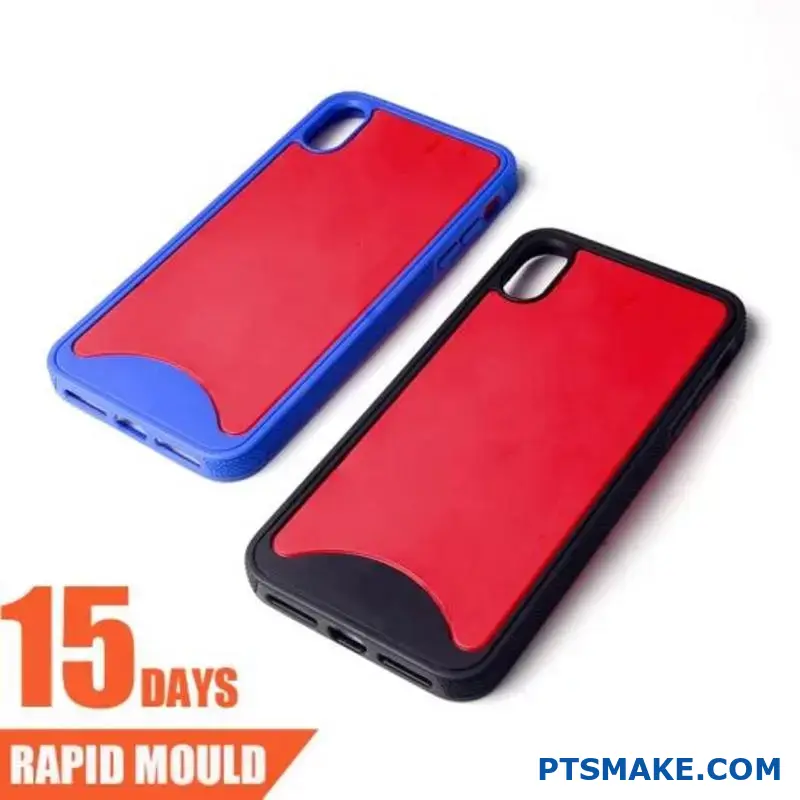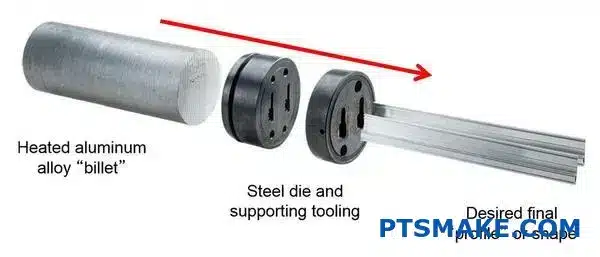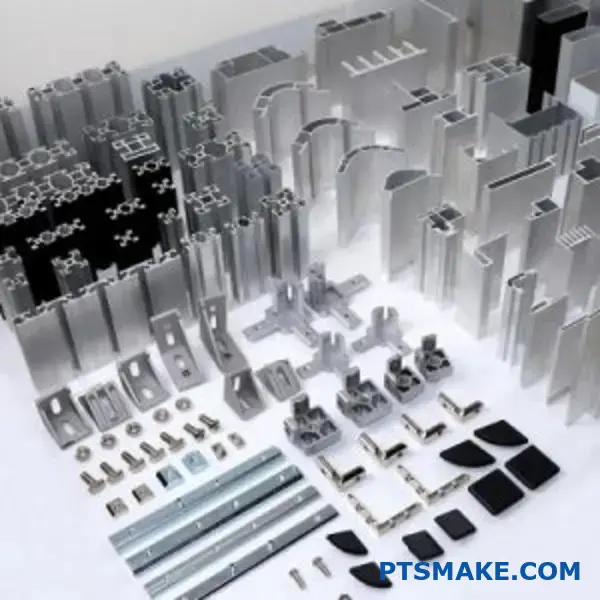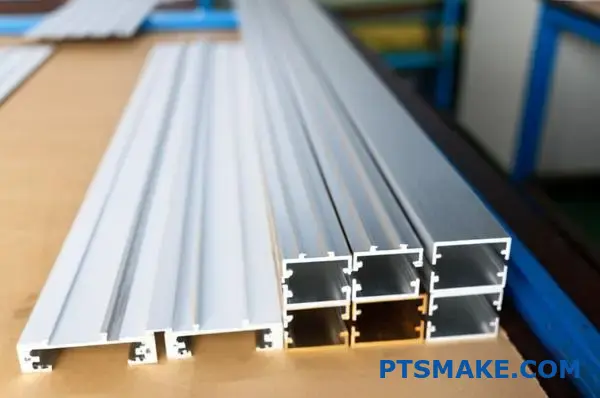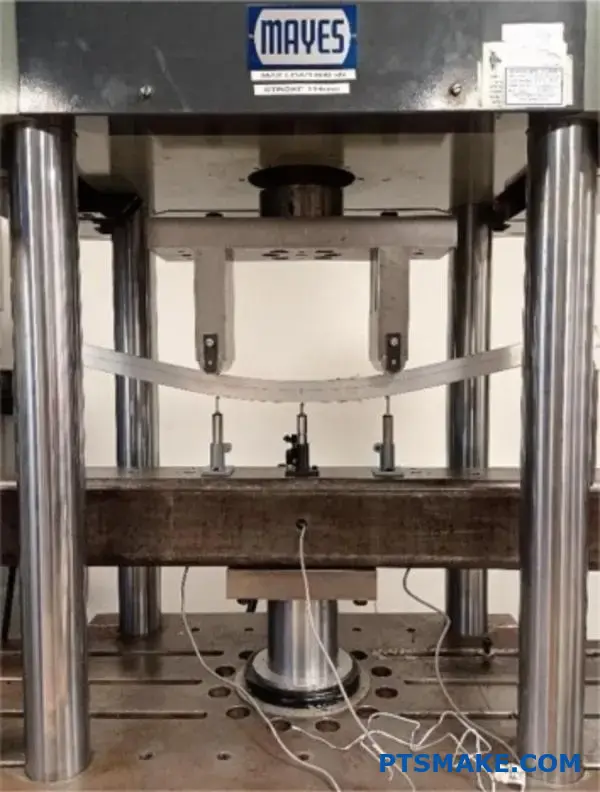Are you struggling to find the right material for your precision components? Many engineers waste time and money on materials that corrode quickly or can’t handle demanding applications. I’ve seen projects fail because teams selected the wrong metal for critical parts.
Bronze machining is the process of cutting and shaping bronze alloys using CNC machines and other tools to create precise parts and components. It involves transforming raw bronze stock into finished products through various operations like milling, turning, drilling, and grinding.
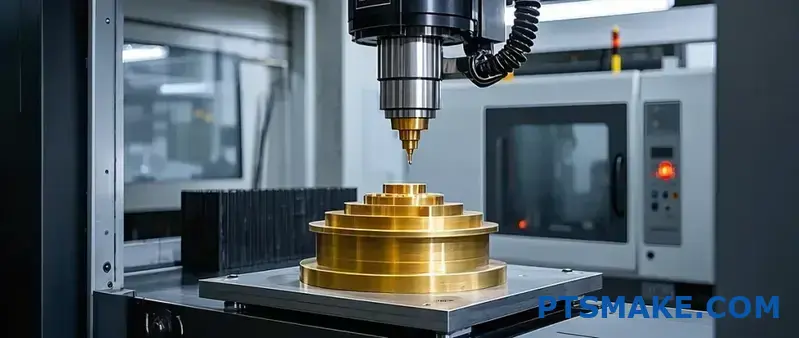
At PTSMAKE, we’ve worked with countless clients who initially overlooked bronze as a solution for their engineering challenges. Bronze offers exceptional corrosion resistance, excellent bearing properties, and impressive strength-to-weight ratios. If you’re looking for a versatile metal that performs reliably in tough environments, keep reading to discover why bronze machining might be the perfect solution for your next project.
Is Brass Or Bronze Better For Machining?
Have you ever stood in front of material options, torn between brass and bronze for your next machining project? That moment of uncertainty, wondering which will give you better results, lower costs, and fewer headaches during manufacturing can be paralyzing.
Brass is generally better for machining than bronze due to its superior machinability, lower cost, and excellent finish. However, bronze offers better corrosion resistance, strength, and wear resistance, making it ideal for specialized applications despite being more difficult to machine.
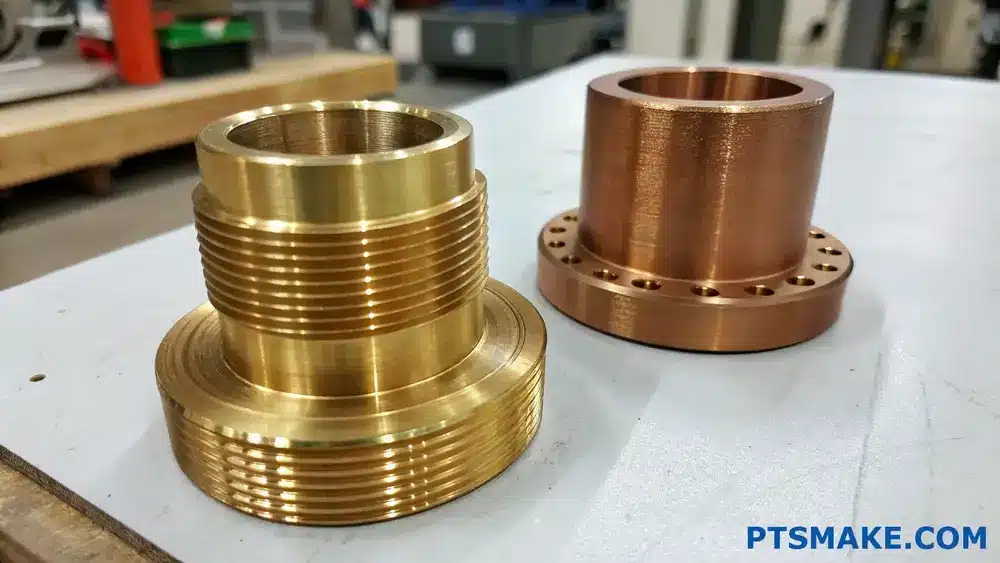
Understanding Brass and Bronze Composition
Before diving into which material is better for machining, it’s essential to understand what brass and bronze actually are. Both are copper alloys, but their composition makes all the difference in machining performance.
Brass Composition
Brass is primarily an alloy of copper and zinc. The zinc content typically ranges from 5% to 45%, giving brass its distinctive golden color. Different types of brass exist based on varying zinc percentages and other added elements:
- Alpha brass: Contains up to 37% zinc, excellent for cold working
- Alpha-beta brass: Contains 37-45% zinc, good for hot working
- Free-cutting brass: Contains lead (1-3%) to improve machinability
The most commonly machined brass is C360 (free-cutting brass), which contains about 61.5% copper, 35.5% zinc, and 3% lead. The lead content significantly improves its machinability by acting as a chip breaker.
Bronze Composition
Bronze is traditionally a copper-tin alloy, though modern bronzes often include other elements like aluminum, silicon, or phosphorus. Some common bronze types include:
- Tin bronze: Contains 10-12% tin
- Aluminum bronze: Contains 5-12% aluminum
- Silicon bronze: Contains 3-4% silicon
- Phosphor bronze: Contains 0.5-1% phosphorus and 5-10% tin
The addition of tin creates a harder, more wear-resistant material compared to brass, but this also impacts its machinability.
Machinability Comparison
When comparing brass and bronze for machining, several factors come into play:
Cutting Speed and Tool Life
In my experience working with both materials at PTSMAKE, brass consistently allows for higher cutting speeds. We can run our CNC machines 20-30% faster when machining brass compared to bronze. This is primarily due to brass’s lower hardness and the beneficial effect of lead content in free-cutting brass grades.
Tool life is also significantly better when machining brass. During a recent production run of 5,000 components, we observed that tool replacement was needed 3 times more frequently with bronze parts compared to similar brass components.
Chip Formation
One of the most noticeable differences when machining these materials is chip formation:
| Material | Chip Type | Chip Control | Surface Finish |
|---|---|---|---|
| Brass | Short, brittle | Excellent | Excellent |
| Bronze | Long, stringy | Poor to moderate | Good to excellent |
Brass produces short, brittle chips that break easily and clear quickly from the cutting area. Bronze, especially tin bronze, tends to form longer, stringier chips that can wrap around the tool or workpiece, requiring more frequent operator intervention.
Surface Finish
Both materials can achieve excellent surface finishes, but brass typically requires less effort to produce a smooth surface. Bronze can develop a beautiful finish but often requires additional steps or more careful parameter selection.
Cost Considerations
Cost is always a crucial factor in material selection. Here’s how brass and bronze compare:
Material Cost
Brass is generally 15-40% less expensive than bronze, depending on the specific alloy. This cost difference can be significant for large production runs. For example, on a recent project involving 200 precision components, choosing brass over bronze saved our client approximately $3,500 in material costs alone.
Machining Costs
The total machining cost includes not just the material but also:
- Machine time (which is less for brass due to higher cutting speeds)
- Tool consumption (lower with brass)
- Labor costs (lower with brass due to less operator intervention)
When all these factors are considered, machining brass can be 20-35% more economical than bronze for many applications.
Application-Specific Considerations
Despite brass being generally easier to machine, bronze remains the better choice for certain applications due to its superior properties in specific conditions.
Strength and Wear Resistance
Bronze, particularly aluminum bronze, offers superior tensile strength1 and wear resistance compared to brass. This makes bronze preferable for components subject to high mechanical stress or abrasive environments, such as bearings, bushings, and marine propellers.
Corrosion Resistance
Bronze typically outperforms brass in corrosion resistance, especially in marine environments. While both contain copper, the aluminum or silicon in bronze provides better protection against saltwater corrosion than the zinc in brass.
Electrical and Thermal Properties
Brass has better electrical conductivity than most bronzes, making it preferred for electrical components. However, some bronze alloys offer better thermal conductivity, which can be crucial for heat-dissipating applications.
Making the Right Choice
Based on my experience, here’s a simplified decision framework:
Choose brass when:
- Machinability and cost are primary concerns
- High production volumes are required
- The application doesn’t face extreme corrosion or wear
Choose bronze when:
- Wear resistance is critical
- Corrosion resistance (especially in marine environments) is needed
- The component must withstand high mechanical stress
- The higher machining cost is justified by the performance requirements
Does Bronze Have Good Machinability?
Have you ever found yourself wondering if bronze is the right material for your machining project? Maybe you’ve experienced challenges with other metals and are looking for a material that won’t leave you frustrated with poor surface finishes or excessive tool wear?
Yes, bronze generally has excellent machinability. Most bronze alloys cut cleanly, produce manageable chips, and allow for good surface finishes without excessive tool wear. However, machinability varies significantly between different bronze alloys, with lead-containing bronzes offering superior machinability while aluminum bronzes present more challenges.
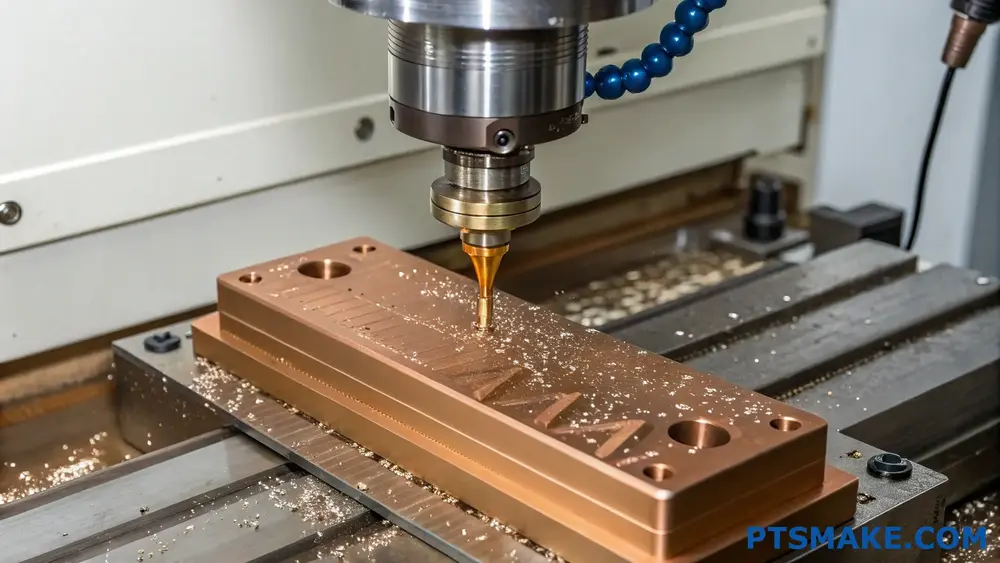
Understanding Bronze Machinability Factors
Bronze is one of the oldest engineered metals, dating back thousands of years, yet it remains relevant in modern manufacturing. In my experience at PTSMAKE, bronze continues to be a popular choice for many precision components. But what makes bronze either easy or challenging to machine?
Alloy Composition and Its Impact
The composition of bronze significantly affects its machinability. Bronze is primarily a copper-tin alloy, but various elements are added to enhance specific properties. These additions directly influence how the material responds to cutting tools.
Lead-containing bronzes (such as C83600) are among the most machinable bronze alloys. The lead acts as a natural lubricant during machining, reducing friction between the tool and workpiece. This results in smoother cuts, better chip breaking, and extended tool life. In contrast, aluminum bronzes, while offering excellent strength and corrosion resistance, tend to be more challenging to machine due to their hardness and work-hardening characteristics.
Hardness and Ductility Balance
Bronze’s balanced combination of hardness and ductility contributes to its generally good machinability. It’s hard enough to maintain dimensional stability during machining but ductile enough to avoid excessive brittleness that could cause cracking or chipping.
When choosing a bronze alloy for a machining project, I always consider the Brinell hardness value as an indicator of machinability. Typically, bronze alloys with a Brinell hardness between 60-90 offer the best machinability, while maintaining adequate mechanical properties for most applications.
Comparing Different Bronze Alloys for Machinability
Different bronze alloys exhibit varying degrees of machinability. Understanding these differences helps in selecting the right alloy for specific machining requirements.
Tin Bronzes (Phosphor Bronze)
Tin bronzes, including phosphor bronzes (C51000, C52100), offer reasonable machinability with hardness ratings around 75-85 Brinell. Their cutting characteristics include:
- Moderate cutting forces required
- Good surface finish potential
- Medium chip formation
- Moderate tool wear
These alloys form continuous chips that sometimes require chip breakers or appropriate cutting parameters to manage effectively.
Leaded Bronzes
Leaded bronzes (C83600, C93200) demonstrate superior machinability among bronze alloys. The presence of lead (sometimes up to 10%) dramatically improves machining characteristics:
- Lower cutting forces
- Excellent chip breaking
- Reduced built-up edge on cutting tools
- Extended tool life
- Superior surface finishes
The free-machining properties2 of leaded bronzes make them ideal for intricate parts requiring precision tolerances. However, environmental and health concerns regarding lead have led to restrictions in some applications.
Aluminum Bronzes
Aluminum bronzes (C95400, C95500) present greater machining challenges due to their higher strength and work-hardening tendencies. Their machining characteristics include:
- Higher cutting forces required
- Potential for work hardening during machining
- Abrasive wear on cutting tools
- More difficult chip control
Despite these challenges, with proper tooling and cutting parameters, aluminum bronzes can be machined effectively to produce high-quality components.
Optimizing Bronze Machining Parameters
Based on my experience with numerous bronze machining projects, I’ve found that optimizing machining parameters significantly improves outcomes when working with bronze.
Cutting Speed and Feed Recommendations
The table below provides general recommendations for machining different bronze alloys:
| Bronze Type | Cutting Speed (SFM) | Feed Rate (in/rev) | Depth of Cut (in) |
|---|---|---|---|
| Leaded Bronze | 300-600 | 0.005-0.020 | 0.050-0.250 |
| Tin Bronze | 200-450 | 0.004-0.015 | 0.040-0.200 |
| Aluminum Bronze | 150-350 | 0.003-0.012 | 0.030-0.150 |
These parameters serve as starting points and may require adjustment based on specific machining conditions, tooling, and equipment capabilities.
Tool Selection for Bronze Machining
For optimal results when machining bronze, I recommend:
- Carbide tools for general machining operations
- High-speed steel (HSS) tools for specific applications
- Tools with positive rake angles (5° to 15°)
- Adequate relief angles (5° to 10°)
- Polished tool faces to reduce built-up edge formation
At PTSMAKE, we’ve found that using proper coolant systems also significantly improves machining performance with bronze. Water-soluble oils provide excellent cooling and lubrication for most bronze machining operations.
Common Challenges and Solutions in Bronze Machining
Even with bronze’s generally good machinability, certain challenges may arise. Understanding these challenges and their solutions ensures successful machining outcomes.
Surface Finish Issues
Bronze can sometimes develop poor surface finishes due to:
- Built-up edge on cutting tools
- Inappropriate cutting speeds
- Dull tooling
- Inadequate coolant application
To achieve superior surface finishes on bronze components, I implement these strategies:
- Maintain sharp cutting edges
- Use appropriate coolant flow directed at the cutting zone
- Apply higher cutting speeds with moderate feeds
- Consider burnishing operations for critical surface finish requirements
Tool Wear Considerations
Tool wear when machining bronze varies by alloy type. Aluminum bronzes cause more abrasive wear, while leaded bronzes are gentler on tooling. To maximize tool life when machining bronze:
- Select appropriate tool materials based on the specific bronze alloy
- Apply proper cooling and lubrication
- Monitor tool condition regularly
- Use optimized cutting parameters that balance productivity with tool life
At PTSMAKE, implementing these strategies has allowed us to achieve excellent results when machining various bronze alloys, delivering high-precision components with optimal efficiency.
What Is The Best Bronze For Machining?
Ever struggled to select the right bronze alloy for your machining project? It’s frustrating when you’ve invested in material only to discover it doesn’t machine well, causing tool wear, poor surface finishes, or even scrapped parts. The choice between dozens of bronze types can be overwhelming.
The best bronze for machining is typically C36000 (free-cutting brass) due to its excellent machinability rating of 100%. For applications requiring true bronze, C54400 (phosphor bronze) offers superior machinability while maintaining good strength, wear resistance, and corrosion properties needed for industrial applications.
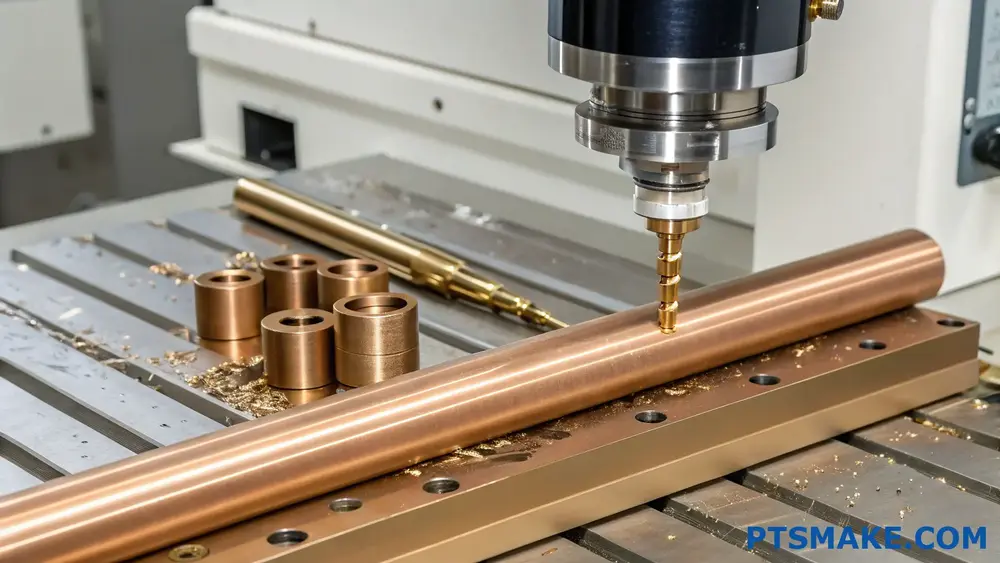
Key Factors That Determine Bronze Machinability
When evaluating bronze for machining applications, several critical properties determine how well the material will perform. After working with countless bronze alloys at PTSMAKE, I’ve found that understanding these factors helps engineers make better material decisions.
Chemical Composition and Its Impact
The chemical makeup of bronze significantly affects its machinability. Traditional bronze is primarily a copper-tin alloy, but modern variants contain various elements that dramatically alter machining characteristics:
- Lead (Pb): Acts as a chip breaker and lubricant, significantly improving machinability
- Zinc (Zn): Increases fluidity and reduces friction during cutting
- Phosphorus (P): Improves strength but can make the material harder to machine
- Silicon (Si): Increases hardness and wear resistance but requires adjusted cutting parameters
Leaded bronzes like C93200 (SAE 660) machine exceptionally well because the lead particles create discontinuities in the metal matrix, helping chips break free easily during machining operations.
Hardness vs. Machinability Trade-offs
There’s always a balance between hardness and ease of machining. This relationship follows a general pattern:
| Bronze Type | Brinell Hardness | Relative Machinability | Best Applications |
|---|---|---|---|
| Leaded Bronze | 60-80 BHN | Excellent (80-100%) | Bearings, bushings, low-pressure components |
| Phosphor Bronze | 80-120 BHN | Good (60-70%) | Gears, springs, electrical components |
| Aluminum Bronze | 110-180 BHN | Fair (40-50%) | Marine hardware, wear plates, pump components |
| Silicon Bronze | 90-140 BHN | Poor to Fair (30-45%) | Architectural applications, corrosive environments |
The machinability rating3 is often given as a percentage, with free-cutting brass (C36000) used as the 100% reference standard.
Top 5 Bronze Alloys for Machining Applications
Based on my experience overseeing bronze machining projects at PTSMAKE, these five bronze alloys consistently deliver the best results:
1. C93200 (SAE 660) Bearing Bronze
This is perhaps the most widely machined bronze alloy due to its excellent combination of properties:
- 7% lead content provides superior chip formation
- Moderate hardness (80 BHN) allows for fast material removal
- Excellent bearing properties for the finished part
- Machinability rating: 80%
It’s my go-to recommendation when a client needs machined bronze components that will experience moderate loads and sliding contact.
2. C54400 Phosphor Bronze
When higher strength is required without sacrificing too much machinability:
- Contains small amounts of phosphorus that improve strength
- Good machinability with proper tooling
- Superior spring properties and fatigue resistance
- Machinability rating: 65%
3. C95400 Aluminum Bronze
For applications requiring high strength and excellent corrosion resistance:
- Contains 10-11% aluminum for increased hardness
- Requires slower cutting speeds but produces excellent finishes
- Outstanding wear resistance in the finished part
- Machinability rating: 50%
4. C90300 Tin Bronze
A true bronze with excellent dimensional stability:
- Contains 8% tin, minimal lead
- Good machinability when proper feeds and speeds are used
- Excellent for pressure-tight applications
- Machinability rating: 60%
5. C64200 Silicon Bronze
When corrosion resistance is paramount:
- Contains 3% silicon for improved strength and corrosion resistance
- More difficult to machine but produces excellent surface finishes
- Outstanding performance in marine environments
- Machinability rating: 40%
Optimizing Machining Parameters for Bronze
The key to successful bronze machining lies in selecting the right cutting parameters. At PTSMAKE, we’ve refined these approaches through years of experience:
Cutting Speed and Feed Recommendations
| Bronze Type | Cutting Speed (SFM) | Feed Rate (IPR) | Depth of Cut (inches) |
|---|---|---|---|
| Leaded Bronze | 300-500 | 0.005-0.015 | 0.050-0.250 |
| Phosphor Bronze | 200-350 | 0.003-0.010 | 0.030-0.200 |
| Aluminum Bronze | 150-250 | 0.002-0.008 | 0.020-0.150 |
| Silicon Bronze | 150-300 | 0.002-0.008 | 0.020-0.150 |
These parameters serve as starting points; I always recommend adjusting based on specific machinery and tooling.
Coolant Selection and Tool Geometry
For optimal bronze machining results:
Coolant: Sulfurized mineral oil-based cutting fluids work exceptionally well for bronze. Water-soluble coolants at 8-10% concentration are also effective.
Tool Geometry:
- HSS tools: Use rake angles of 5-10 degrees for most bronzes
- Carbide tools: Positive rake angles (5-8 degrees) work best
- Tool nose radius: Larger radii (0.030-0.060") improve surface finish
Chip Control: Bronze tends to produce long, stringy chips. Tools with chip breakers specifically designed for non-ferrous materials yield the best results.
When machining silicon or aluminum bronze, I’ve found that reducing speeds by 20-30% compared to leaded bronze and using tools with higher positive rake angles significantly improves both tool life and surface finish.
What Lasts Longer, Brass Or Bronze?
Have you ever invested in metal components only to find them deteriorating faster than expected? Or perhaps you’re torn between brass and bronze for a project where longevity is crucial? The frustration of choosing the wrong alloy can lead to costly replacements and project delays that nobody wants to deal with.
Bronze typically lasts longer than brass due to its superior corrosion resistance, especially in marine environments. While brass offers better malleability and lower cost, bronze’s durability, weather resistance, and higher copper content make it the superior choice for long-term applications exposed to harsh conditions.

Durability Factors That Affect Longevity
When comparing brass and bronze, we need to consider several key factors that influence their lifespan. Both are copper alloys, but their composition creates significant differences in how they withstand time and environmental conditions.
Corrosion Resistance
Bronze holds a clear advantage when it comes to corrosion resistance. Its high copper content combined with tin (rather than zinc found in brass) creates a material that’s naturally more resistant to various forms of degradation. This is particularly evident in marine applications where salt water can quickly compromise less resistant metals.
In my experience working with manufacturers in coastal regions, bronze components consistently outlast brass alternatives when exposed to salt spray. The natural patina that forms on bronze actually serves as a protective layer, preventing further corrosion and extending the component’s useful life.
Environmental Factors
Environmental conditions play a crucial role in determining which metal will last longer:
| Environment | Brass Performance | Bronze Performance |
|---|---|---|
| Marine/Saltwater | Poor to moderate | Excellent |
| Fresh Water | Good | Very good |
| Outdoor (Urban) | Moderate | Good |
| Indoor | Excellent | Excellent |
| Industrial (Chemical) | Poor | Moderate |
Temperature fluctuations and humidity levels also affect longevity. Bronze maintains its structural integrity better under temperature extremes, while brass may experience more significant dimensional changes that can compromise precision components over time.
Wear Resistance
When it comes to mechanical wear, bronze typically demonstrates superior performance. This is why you’ll often see bronze bearings, bushings, and gears in applications where friction is constant. The material’s tribological properties4 make it ideal for these high-wear scenarios.
Brass, while softer, does have applications where its wear characteristics are beneficial – particularly when paired with harder metals where some degree of "give" is desirable to reduce wear on more expensive components.
Composition Differences Affecting Longevity
The fundamental difference between these alloys lies in their composition:
- Brass: Primarily copper and zinc (usually 60-70% copper, 30-40% zinc)
- Bronze: Primarily copper and tin (typically 88-95% copper, 5-12% tin)
These compositional differences directly impact longevity in several ways:
Dezincification in Brass
One of the most significant vulnerabilities of brass is dezincification – a process where zinc leaches out of the alloy when exposed to certain conditions, particularly acidic or chloride-rich environments. This leaves behind a porous, weakened structure that’s prone to failure.
At PTSMAKE, I’ve seen numerous cases where brass components failed prematurely in industrial applications due to this specific degradation mechanism. The resulting porosity not only compromises structural integrity but can lead to leaks in fluid systems – a particularly problematic failure mode in hydraulic components.
Alloying Elements and Their Effects
Additional elements in both alloys can significantly alter their durability:
- Lead in brass improves machinability but can reduce corrosion resistance
- Aluminum in bronze creates aluminum bronze, which offers exceptional strength and resistance to wear
- Silicon in bronze improves fluidity for casting applications while maintaining good corrosion resistance
Real-World Applications and Lifespan
From my 15+ years of experience in precision manufacturing, I’ve observed clear patterns in how these metals perform in various applications:
Marine Applications
For marine components, bronze is the clear winner. Naval architecture has relied on bronze for centuries precisely because of its exceptional resistance to seawater corrosion. Propellers, rudder fittings, and underwater hardware manufactured from bronze can last decades, while brass equivalents might need replacement within a few years.
Architectural Elements
In architectural applications exposed to weather, bronze typically maintains its integrity for 50+ years with minimal maintenance. The distinctive patina that develops—ranging from brown to green depending on environmental conditions—not only protects the metal but is often considered aesthetically desirable.
Brass architectural elements, while initially more brilliant, require more frequent maintenance to prevent deterioration, particularly in coastal or industrial environments.
Mechanical Components
For mechanical parts subject to friction and wear, bronze’s superior hardness and wear resistance translate to a longer operational life. This is why bronze continues to be the preferred material for bearings, bushings, and gears in critical applications where failure would be costly or dangerous.
When designing with longevity in mind, we at PTSMAKE often recommend bronze for components that will experience significant mechanical stress combined with environmental exposure. The additional material cost is typically offset by the extended service life and reduced maintenance requirements.
What Are The Common Challenges In Bronze Machining?
Have you ever tried machining bronze components only to end up with subpar results? Or perhaps you’ve struggled with unexpected tool wear that derailed your production timeline? Bronze machining seems straightforward but often hides complexities that can frustrate even experienced machinists.
Bronze machining presents several common challenges including tool wear, material hardness variations, chip control problems, thermal management issues, and surface finish difficulties. Understanding these challenges is essential for achieving precision results and extending tool life when working with bronze alloys.
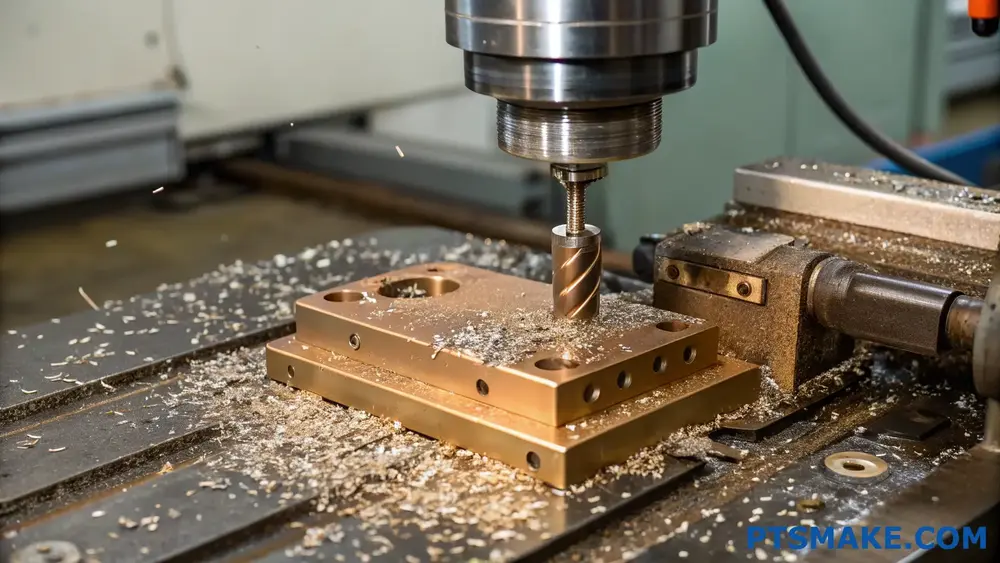
Understanding Material Hardness Variations
One of the most significant challenges I encounter in bronze machining is dealing with the variations in material hardness. Bronze alloys contain different proportions of copper and other elements like tin, aluminum, silicon, or phosphorus. Each composition results in different hardness levels.
For example, tin bronzes (with 10-12% tin) tend to be significantly harder than aluminum bronzes. When your supplier provides material with slightly different compositions than specified, your carefully calculated cutting parameters suddenly become ineffective.
At PTSMAKE, we’ve implemented rigorous material testing protocols to address this challenge. Before beginning any bronze machining project, we verify the exact composition and hardness of the material. This extra step has saved countless hours of troubleshooting and rework.
Material Hardness Testing Methods for Bronze
Several methods help determine the exact hardness of bronze materials:
- Brinell Hardness Testing – Ideal for cast bronze components
- Rockwell Hardness Testing – Better for wrought bronze with uniform structure
- Portable Hardness Testing – Useful for large bronze workpieces
Implementing these testing methods provides the data needed to adjust machining parameters appropriately.
Rapid Tool Wear and Degradation
Tool wear is another major challenge in bronze machining. Bronze’s abrasive nature, particularly in alloys containing silicon or aluminum, can lead to premature tool degradation5 and failure.
When machining phosphor bronze, I’ve observed cutting tools becoming dull up to 40% faster than when cutting mild steel. This accelerated wear not only increases tooling costs but also impacts dimensional accuracy as the tool geometry changes.
To combat this issue:
- Use carbide tools with appropriate coatings (TiAlN or diamond coatings work well)
- Implement more frequent tool inspection cycles
- Consider ceramic or CBN cutting tools for high-volume production runs
The correct tool material selection based on the specific bronze alloy can extend tool life by 2-3 times compared to standard HSS tooling.
Chip Control Problems
Managing chip formation and evacuation presents unique challenges when machining bronze. Unlike some materials that form neat, predictable chips, bronze can produce long, stringy chips that wrap around the tool or workpiece.
These problematic chips can:
- Scratch finished surfaces
- Interfere with coolant flow
- Create safety hazards for operators
- Lead to inconsistent cutting conditions
I’ve found that implementing proper chip breaker geometry and adjusting feed rates can significantly improve chip control. For instance, increasing the feed rate by 15-20% while maintaining the same cutting speed often transforms problematic stringy chips into more manageable comma-shaped chips.
Thermal Management Challenges
Bronze’s thermal conductivity varies widely across different alloys, creating challenges in managing heat during machining operations. This table illustrates the thermal conductivity differences:
| Bronze Alloy Type | Thermal Conductivity (W/m·K) | Relative Machining Difficulty |
|---|---|---|
| Copper-based | 26-50 | Moderate |
| Aluminum Bronze | 30-83 | High |
| Phosphor Bronze | 22-50 | Moderate to High |
| Silicon Bronze | 35-45 | Very High |
Bronze’s relatively high thermal conductivity compared to steel means heat dissipates quickly throughout the workpiece. While this helps prevent localized overheating, it can lead to dimensional accuracy issues as the entire workpiece expands during machining.
For precision bronze components, I implement temperature-controlled environments and allow workpieces to reach thermal equilibrium before finishing operations.
Surface Finish Difficulties
Achieving consistent surface finishes on bronze components can be particularly challenging. Bronze’s softness compared to steel means it can smear rather than cut cleanly, resulting in surface imperfections.
The solution lies in:
- Using sharp tooling with positive rake angles
- Implementing finishing passes with light depths of cut
- Selecting appropriate cutting fluids (sulfurized oils often work best)
- Maintaining consistent feed rates throughout the operation
When machining ornamental bronze components at PTSMAKE, we’ve developed specialized polishing processes that follow CNC operations to achieve mirror-like finishes where required.
Galvanic Corrosion Considerations
While not strictly a machining challenge, ensuring machined bronze components don’t experience galvanic corrosion in their final application is critical. When bronze contacts dissimilar metals in the presence of an electrolyte, accelerated corrosion can occur.
This potential issue must be considered during the design and machining process by:
- Planning for appropriate protective coatings
- Designing isolation between dissimilar metals
- Ensuring proper post-machining cleaning to remove conductive residues
Post-Machining Treatment Recommendations
To maximize the performance of machined bronze components, consider these post-processing steps:
- Heat treatment for stress relief
- Surface passivation to enhance corrosion resistance
- Application of protective coatings where appropriate
- Proper cleaning to remove all machining residues
By addressing these challenges systematically, bronze machining becomes much more manageable. With 15+ years in the industry, I’ve found that proper planning and material knowledge are the keys to successful bronze machining projects.
How Does Bronze Machining Affect Part Tolerances?
Have you ever received bronze components that just wouldn’t fit together properly? Or perhaps you’ve designed a precision bronze part only to find the final machined product doesn’t meet your specifications? The frustration of dealing with parts that fall outside acceptable tolerance ranges can derail projects and increase costs dramatically.
Bronze machining affects part tolerances primarily through the material’s thermal expansion properties, tool wear patterns, and its tendency to spring back during cutting operations. Proper machining techniques, tooling selection, and process controls are essential to maintain tight tolerances in bronze components.
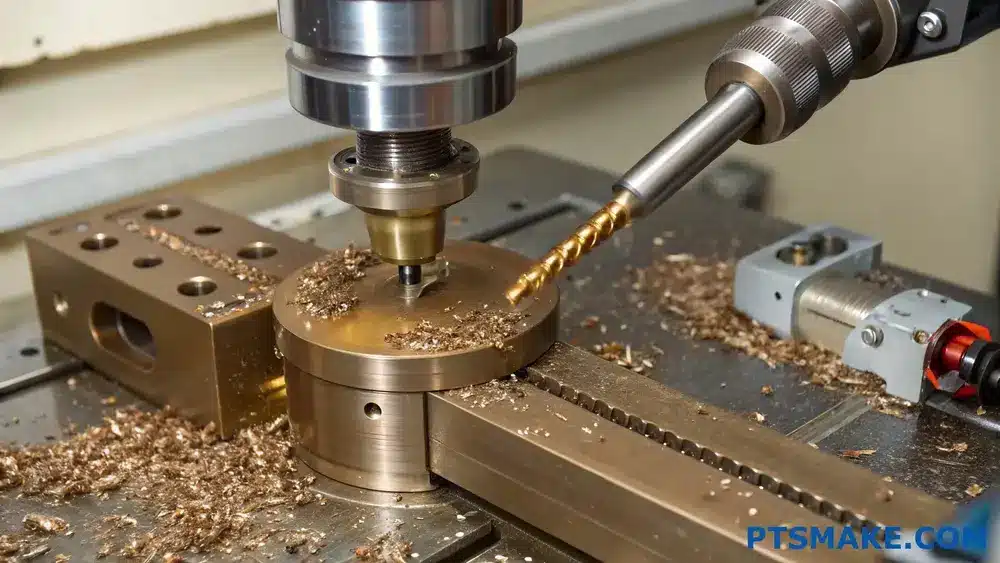
Material Properties and Their Impact on Tolerances
Bronze alloys possess unique physical properties that directly influence machining tolerances. When working with bronze, I’ve found that understanding these fundamental material characteristics is crucial for achieving precise dimensions.
Thermal Expansion Considerations
Bronze has a relatively high coefficient of thermal expansion compared to other common machining materials. During machining operations, the friction between cutting tools and the workpiece generates heat, causing the bronze to expand. This thermal expansion can significantly affect dimensional accuracy, especially in precision applications.
In my experience at PTSMAKE, temperature control during machining is essential for maintaining tight tolerances. For components requiring tolerances under ±0.001", we implement strict temperature control protocols in our CNC machining facility. This includes:
- Maintaining consistent ambient temperature in the machining area
- Using coolant systems to minimize heat buildup
- Allowing parts to reach thermal equilibrium before final measurements
Material Hardness and Tool Wear
Bronze alloys vary significantly in hardness, which directly impacts machining tolerances. Softer bronzes like tin bronze tend to produce built-up edges on cutting tools, while harder varieties like aluminum bronze can accelerate tool wear.
I’ve observed that tool wear is one of the primary factors affecting tolerance consistency during long production runs. As tools wear, dimensions gradually shift, potentially causing parts to fall out of specification. For critical bronze components, we implement the following practices:
- Regular tool inspection and replacement schedules
- In-process dimension verification
- Tool path compensation based on wear patterns
Machining Techniques for Optimal Tolerances
The choice of machining technique significantly impacts achievable tolerances in bronze components. Different approaches offer varying levels of precision and consistency.
CNC Milling vs. Turning for Bronze
When precision is paramount, the selection between milling and turning operations becomes critical. The following table outlines the typical tolerance capabilities for bronze machining methods:
| Machining Method | Typical Tolerance Range | Best for |
|---|---|---|
| CNC Milling | ±0.002" to ±0.0005" | Complex geometries, flat surfaces |
| CNC Turning | ±0.001" to ±0.0003" | Cylindrical features, external threads |
| Grinding | ±0.0005" to ±0.0001" | Super-precision surfaces, finishing |
| EDM | ±0.0005" to ±0.0002" | Intricate features, hard bronze alloys |
For components requiring extremely tight tolerances, we often employ a combination of these processes. Initial rough machining removes the bulk of material, followed by finish machining operations that can achieve higher precision.
Cutting Parameters and Their Effect
Cutting speed, feed rate, and depth of cut directly influence machining tolerances in bronze components. In my experience, optimizing these parameters is essential for consistent results. For most bronze alloys, I recommend:
- Higher cutting speeds than those used for steel (typically 1.5-2 times faster)
- Moderate feed rates to prevent work hardening6 and tool deflection
- Shallow depth of cuts for finish passes to minimize heat generation
Common Tolerance Challenges with Bronze Machining
Despite careful planning, bronze machining presents several challenges that can affect tolerance achievement. Being aware of these issues helps mitigate their impact.
Internal Stress and Distortion
Bronze castings and wrought products often contain residual internal stresses that can cause distortion during machining. As material is removed, these stresses are released, potentially causing the part to warp or twist.
To counter this effect, we employ several strategies:
- Stress relieving heat treatments before precision machining
- Roughing operations that remove material evenly from all sides
- Progressive machining approaches that allow for intermediate stress equalization
Surface Finish Considerations
The relationship between surface finish and dimensional tolerances is particularly important for bronze components. Rougher surfaces not only affect the functional performance of parts but can also complicate precise measurement.
For critical applications, we recommend the following surface finish guidelines for bronze components:
- General mechanical components: 32-63 μin Ra
- Bearing surfaces: 16-32 μin Ra
- Sealing surfaces: 8-16 μin Ra
- Optical component mounting: 4-8 μin Ra
Achieving these surface finishes often requires specific tooling and carefully controlled machining parameters, but the result is significantly improved dimensional control.
Advanced Strategies for Tight-Tolerance Bronze Machining
For applications demanding the tightest tolerances, standard machining approaches may be insufficient. In these cases, specialized techniques become necessary.
Temperature-Compensated Machining
For ultra-precision bronze components, we implement temperature-compensated machining strategies. This approach involves:
- Real-time monitoring of material and ambient temperatures
- Predictive modeling of thermal expansion effects
- Automated adjustment of tool paths based on thermal conditions
These techniques allow us to achieve tolerances as tight as ±0.0001" on certain bronze components, even in less-than-ideal environmental conditions.
Secondary Operations for Enhanced Precision
When machining alone cannot achieve the required tolerances, secondary operations become necessary. For bronze components, common secondary operations include:
- Grinding (surface, cylindrical, or centerless)
- Lapping for extremely flat surfaces
- Honing for precise internal diameters
- Hand fitting for critical mating components
While these secondary operations add cost, they can be essential for meeting the most demanding tolerance requirements in aerospace, medical, and scientific instrumentation applications.
What Surface Finishes Are Achievable With Bronze Machining?
Have you ever received a bronze part that didn’t have the right surface finish for your application? Or struggled to communicate exactly what finish you need to your machining partner? The difference between a perfect finish and a mediocre one can make or break your bronze components.
Bronze machining can achieve surface finishes ranging from mirror-like 0.1 μm Ra to rougher 6.3 μm Ra textures. The achievable finish depends on the bronze alloy, machining method, cutting parameters, and post-processing techniques like polishing, bead blasting, or anodizing.
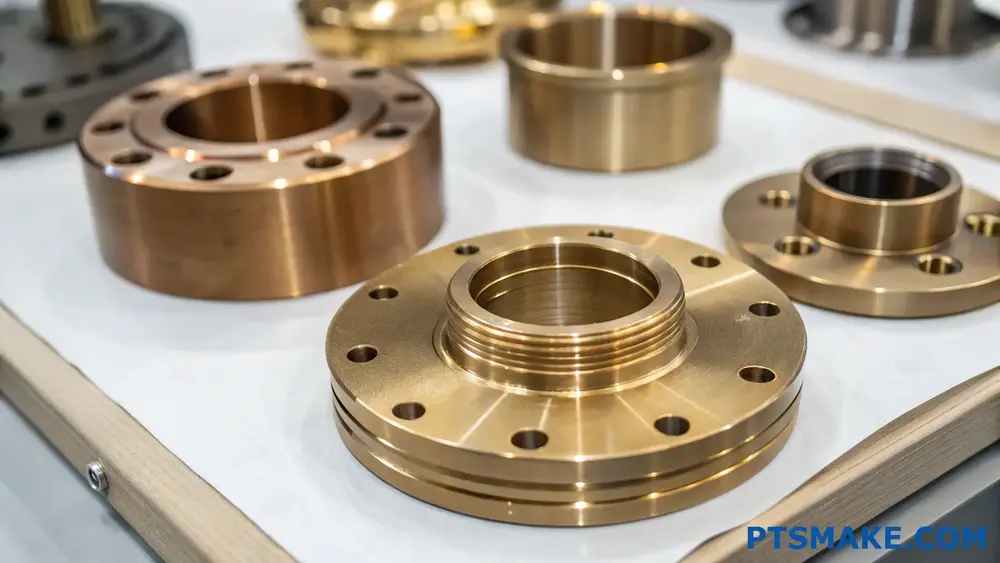
Bronze Surface Finish Fundamentals
Working with bronze requires understanding the unique characteristics of this versatile alloy. Surface finish in bronze machining refers to the texture and appearance of the final machined part’s surface. When discussing surface finish, we typically use the Ra (Roughness Average) value, which measures the average deviation of the surface profile in micrometers (μm).
The lower the Ra value, the smoother the surface. In my experience at PTSMAKE, bronze components can typically achieve surface finishes ranging from 0.1 μm Ra (extremely smooth) to about 6.3 μm Ra (relatively rough), depending on several factors.
Factors Affecting Bronze Surface Finish
Several key factors influence the surface finish quality achievable on bronze components:
Bronze Alloy Type: Different bronze alloys machine differently. Tin bronzes typically produce better surface finishes than aluminum bronzes due to their lower hardness.
Machining Process: The type of machining operation significantly impacts surface finish.
Tool Selection: Proper cutting tool geometry and material can dramatically improve surface finish.
Cutting Parameters: Speed, feed rate, and depth of cut all influence the resulting finish.
Machine Rigidity: More rigid CNC machines produce more consistent, smoother surfaces.
Let me break down how each machining method affects bronze surface finishes.
Surface Finish by Machining Method
CNC Milling
CNC milling is one of the most common methods for machining bronze components. The surface finish achievable through milling depends on several factors:
| Milling Parameter | Surface Finish Impact |
|---|---|
| Tool Type | Ball-end mills produce smoother finishes than flat-end mills |
| Step-over Distance | Smaller step-overs (5-10% of tool diameter) yield finer finishes |
| Cutting Speed | Higher spindle speeds generally produce smoother surfaces |
| Feed Rate | Lower feed rates typically result in better surface finish |
With proper parameters, CNC milling of bronze can achieve surface finishes in the 0.8-3.2 μm Ra range. For especially smooth finishes below 0.8 μm Ra, post-processing is usually required.
CNC Turning
Turning operations on bronze components can achieve excellent surface finishes, often better than milling:
| Turning Parameter | Surface Finish Impact |
|---|---|
| Insert Type | Diamond or CBN inserts produce the finest finishes |
| Insert Radius | Larger nose radius generally yields smoother surfaces |
| Cutting Speed | Higher speeds improve finish but may cause work hardening |
| Feed Rate | Critical factor – slower feeds produce better finishes |
With optimized parameters, CNC turning of bronze can achieve surface finishes as low as 0.4 μm Ra directly from the machine. The lathe calibration7 process is essential for maintaining consistent surface finishes on turned bronze parts.
Grinding and Abrasive Processes
For demanding applications requiring extremely fine surface finishes, grinding operations are often employed:
| Grinding Parameter | Surface Finish Impact |
|---|---|
| Wheel Type | Finer grit wheels produce smoother finishes |
| Wheel Speed | Higher speeds generally yield better finishes |
| Coolant Flow | Proper cooling prevents thermal damage to surface |
| Dressing Frequency | Regularly dressed wheels maintain finish quality |
Surface grinding on bronze can achieve finishes as smooth as 0.1-0.4 μm Ra when properly executed.
Post-Processing Techniques for Bronze
To achieve the finest surface finishes on bronze components, various post-processing techniques can be employed:
Polishing Methods
Polishing can transform a machined bronze surface to achieve mirror-like finishes:
- Mechanical Polishing: Using progressively finer abrasives, finishes below 0.1 μm Ra are possible.
- Vibratory Finishing: Parts are placed in a vibrating bowl with media of varying coarseness.
- Barrel Tumbling: Excellent for deburring and achieving uniform satin finishes.
Surface Treatments
Beyond mechanical finishing, several treatments can enhance bronze surfaces:
- Bead Blasting: Creates a uniform matte finish between 1.6-3.2 μm Ra.
- Chemical Cleaning: Removes oxides and contaminants before final finishing.
- Patination: Controlled oxidation for decorative or protective purposes.
Coating Options
For specialized applications, bronze parts may receive additional coatings:
- Clear Coatings: Preserve appearance and prevent oxidation.
- Electroplating: With metals like nickel for enhanced properties.
- PVD Coatings: For extreme wear resistance while maintaining dimensional accuracy.
Industry-Specific Surface Finish Requirements
Different industries have specific requirements for bronze component surface finishes:
- Marine Applications: Often require 0.8-1.6 μm Ra for propellers and underwater components to reduce biofouling.
- Bearing Applications: Typically need 0.2-0.4 μm Ra for optimal lubrication film development.
- Decorative Use: May require mirror finishes below 0.1 μm Ra for aesthetic appeal.
- Electrical Connectors: Usually need 0.4-0.8 μm Ra for optimal conductivity and contact resistance.
At PTSMAKE, we’ve developed specialized processes for each industry to ensure consistent surface finish results for bronze components.
How To Choose The Right Bronze Alloy For CNC Machining?
Have you ever found yourself staring at a long list of bronze alloys, completely overwhelmed by choice? Or perhaps you’ve selected what seemed like the perfect bronze for your project, only to discover midway that it’s not performing as expected?
Choosing the right bronze alloy for CNC machining requires balancing several factors including mechanical properties, machinability, corrosion resistance, and cost. The ideal selection depends on your specific application requirements, environmental conditions, and budget constraints while considering trade-offs between strength, wear resistance, and conductivity.
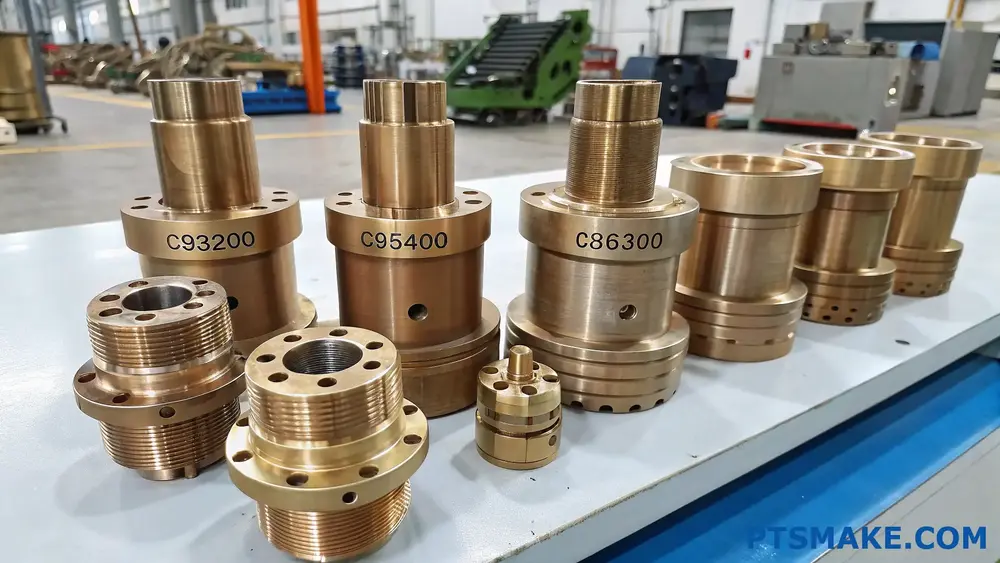
Understanding Bronze Alloy Classifications
Bronze alloys represent one of the most versatile material families available for CNC machining. As someone who has guided countless material selections for precision components, I’ve found that understanding the fundamental classification system is essential before making any choice.
Bronze is primarily a copper-tin alloy, but modern bronze varieties incorporate additional elements that significantly alter their properties. The most common classifications include:
Tin Bronzes
These traditional bronze alloys contain 5-25% tin with the remainder being copper. Their excellent corrosion resistance makes them ideal for marine applications. In my experience, components machined from tin bronze perform exceptionally well in saltwater environments where other metals would quickly deteriorate.
Aluminum Bronzes
Containing 4-11% aluminum and sometimes small amounts of iron and nickel, these bronzes offer superior strength and exceptional corrosion resistance. They’re particularly useful for components that face high mechanical loads while exposed to corrosive environments.
Silicon Bronzes
With 2-4% silicon content, these alloys offer excellent formability and corrosion resistance. They’re widely used in architectural applications and are known for their attractive golden finish that develops a distinctive patina over time.
Phosphor Bronzes
These contain 0.5-11% tin and 0.01-0.35% phosphorus, providing excellent spring qualities and fatigue resistance. I’ve seen phosphor bronze perform remarkably well in electrical applications requiring good conductivity combined with mechanical durability.
Leaded Bronzes
When machining efficiency8 becomes critical, leaded bronzes containing 1-10% lead offer superior results. The lead acts as a chip breaker during machining, reducing tool wear and improving surface finish.
Key Properties to Consider for CNC Machining
When selecting a bronze alloy for CNC machining, several key properties determine both manufacturability and end-use performance:
Machinability Rating
Bronze alloys vary significantly in their machinability, which directly impacts production costs and quality:
| Bronze Type | Machinability Rating (%) | Chip Formation | Tool Life |
|---|---|---|---|
| Leaded Bronze (C93200) | 80-90 | Excellent | Very Good |
| Phosphor Bronze (C51000) | 40-50 | Good | Moderate |
| Aluminum Bronze (C95400) | 30-40 | Fair | Fair |
| Silicon Bronze (C65500) | 50-60 | Good | Good |
Mechanical Properties
Understanding the mechanical requirements of your application is crucial for proper selection:
| Property | High-Strength Bronzes | Standard Bronzes | Low-Strength Bronzes |
|---|---|---|---|
| Tensile Strength (MPa) | 550-850 | 350-550 | 220-350 |
| Yield Strength (MPa) | 250-450 | 150-250 | 90-150 |
| Elongation (%) | 10-20 | 20-30 | 30-45 |
| Hardness (Brinell) | 150-220 | 80-150 | 60-80 |
Corrosion Resistance
Bronze’s excellent corrosion resistance is often a key selection factor:
| Environment | Recommended Bronze Types |
|---|---|
| Saltwater | Tin Bronze, Aluminum Bronze |
| Industrial Chemicals | Silicon Bronze, Phosphor Bronze |
| Atmospheric Exposure | Silicon Bronze, Tin Bronze |
| Fresh Water | Most Bronze Types |
Application-Specific Recommendations
Based on my experience at PTSMAKE with precision bronze machining, I’ve developed some application-specific guidelines:
Bearing and Wear Applications
For components experiencing friction and wear, I typically recommend:
- C93200 (bearing bronze) for general-purpose bearings
- C95400 aluminum bronze for high-load bearings
- C90300 tin bronze for moderate loads with excellent durability
The self-lubricating properties of certain bronze alloys make them superior to other metals in applications where maintenance is difficult.
Marine Components
For saltwater environments, corrosion resistance becomes paramount:
- C92200 (Navy M) bronze for propellers and underwater fittings
- C95500 nickel-aluminum bronze for critical marine components
- C65500 silicon bronze for fasteners and non-structural marine hardware
Electrical Applications
When electrical conductivity is required alongside mechanical properties:
- C51000 phosphor bronze for electrical contacts and springs
- C65500 silicon bronze for electrical connectors requiring strength
- C94700 for applications needing both electrical conductivity and bearing properties
Cost-Benefit Considerations
When working with clients at PTSMAKE, I always emphasize that material cost should be evaluated against lifecycle costs. While some bronze alloys might cost 20-30% more initially, they often provide:
- Extended component lifespan (sometimes 2-3 times longer)
- Reduced maintenance requirements
- Lower system downtime
- Improved safety margins
For example, using C95400 aluminum bronze instead of standard C83600 red brass might increase material costs, but the superior strength and corrosion resistance typically result in significantly lower total ownership costs for critical components.
Machining Process Adaptations
Different bronze alloys require specific machining approaches:
Cutting Speed Adjustments
- Leaded bronzes: Can be machined at higher speeds (up to 400 sfm)
- Aluminum bronzes: Require moderate speeds (150-250 sfm)
- Tin bronzes: Machine best at moderate speeds (200-300 sfm)
Tool Selection
- Leaded bronzes: Standard HSS tools work well
- Aluminum bronzes: Carbide tools recommended
- Silicon bronzes: Sharp tools with positive rake angles
At PTSMAKE, we’ve found that matching the right cutting parameters to each bronze type is essential for achieving tight tolerances and excellent surface finishes.
Learn how material strength affects your machining project success and longevity. ↩
Learn about how these properties impact machining efficiency and quality. ↩
This technical rating helps compare machining efficiency between different metals. ↩
Learn about friction behavior between surfaces and how it affects component longevity. ↩
Learn about tool wear mechanisms and how to prevent them in bronze machining. ↩
Learn how this metallurgical phenomenon impacts your part quality and machining strategy. ↩
Learn about precise machining calibration methods for superior bronze finishes. ↩
Click to learn advanced machining techniques for bronze alloys. ↩


